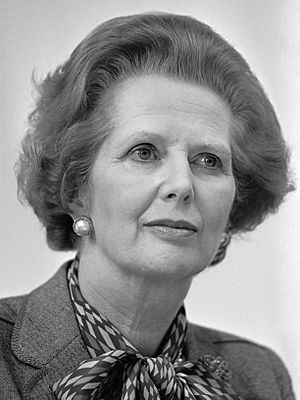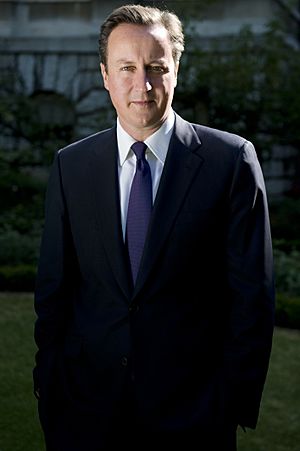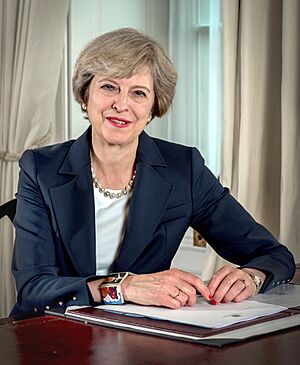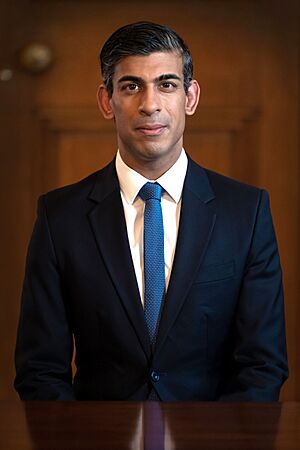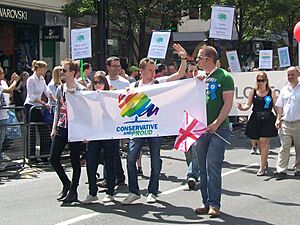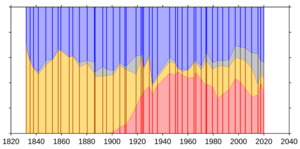Conservative Party (UK) facts for kids
Quick facts for kids
Conservative and Unionist Party
|
|
|---|---|
| Leader | Kemi Badenoch |
| Lords Leader | The Lord True |
| Chief Whips | |
| Chairman | Kevin Hollinrake |
| Chief Executive | Stephen Massey |
| Founded |
|
| Merger of |
|
| Preceded by | Tories |
| Headquarters | Conservative Campaign Headquarters 4 Matthew Parker Street, London SW1H 9HQ |
| Youth wing | Young Conservatives |
| Women's wing | Conservative Women's Organisation |
| Overseas wing | Conservatives Abroad |
| LGBT wing | LGBT+ Conservatives |
| Membership (July 2025) | |
| Ideology |
|
| Political position | Centre-right to right-wing |
| International affiliation | International Democracy Union |
| Irish affiliation |
|
| Colours | Sky blue |
| Slogan | "Renew and Rebuild" (2024) |
| Governing body | Conservative Party Board |
| Devolved or semi-autonomous branches |
|
| Parliamentary party | 1922 Committee |
| House of Commons |
120 / 650
|
| House of Lords |
243 / 777
|
| Scottish Parliament |
30 / 129
|
| Senedd |
14 / 60
|
| London Assembly |
8 / 25
|
| Directly elected regional mayors in England |
2 / 14
|
| Directly elected single authority mayors in England |
2 / 13
|
| Councillors |
4,326 / 18,645
|
| Councils led |
66 / 370
|
| PCCs and PFCCs |
18 / 37
|
The Conservative and Unionist Party, often called the Conservative Party or simply the Tories, is one of the two main political parties in the United Kingdom. It is usually seen as a centre-right to right-wing party. After the 2024 general election, the Conservative Party became the second-largest party in the House of Commons. This means they now play the role of His Majesty's Most Loyal Opposition, which is the main group that challenges the government.
The Conservative Party started in 1834 from the Tory Party. It was one of the two most powerful parties in the 1800s, along with the Liberal Party. Under Benjamin Disraeli, it was very important during the time of the British Empire. In 1912, the Liberal Unionist Party joined with the Conservatives to form the Conservative and Unionist Party. For the last 100 years, its competition with the Labour Party has shaped British politics. David Cameron tried to make the party more modern after he became leader in 2005. The party was in power from 2010 to 2024, with five different prime ministers, the last one being Rishi Sunak.
The party generally supports free market ideas, which means they like less government control over businesses. They also believe in British unionism, meaning they want the United Kingdom to stay together. They have been critical of devolution, which is when power is given from the central government to local regions. In the past, the party supported the British Empire. The Conservatives have had different views on the European Union (EU), with some wanting to leave (Eurosceptics) and some wanting to stay (pro-Europeans). They also support having their own nuclear weapons and being part of NATO.
Historically, the party's supporters were often homeowners, business owners, farmers, and middle-class voters, especially in rural areas of England. Since the EU referendum in 2016, the Conservatives have also tried to gain support from working-class voters. The party has been very successful in elections throughout the 1900s. The most recent time the Conservatives were in government was a period of big political changes.
Contents
- Party History
- Party Policies
- Foreign Policy
- Party Organisation
- Party Groups
- Election Results
- Images for kids
- See also
Party History
How the Party Started
Some people believe the Conservative Party grew out of the older Tory Party. Other historians think it started with a group around William Pitt the Younger in the 1780s. These groups were sometimes called "Friends of Mr Pitt" or "Pittites". The word "Tory" was originally an insult, meaning "outlaw" or "robber" in Irish.
The name "Conservative" was first suggested in an article in 1830. It quickly became popular and was officially adopted around 1834 by Robert Peel. Peel is known as the founder of the Conservative Party, and he announced its goals in something called the Tamworth Manifesto. By 1845, "Conservative Party" was the most common name.

From 1867 to 1914: Conservatives and Unionists
As more people gained the right to vote in the 1800s, the Conservative Party had to change its approach. Under Edward Smith-Stanley, 14th Earl of Derby, and Benjamin Disraeli, they helped pass the Reform Act 1867, which allowed more people to vote. In 1886, the party joined with the new Liberal Unionist Party. Together, under leaders like Robert Gascoyne-Cecil and Arthur Balfour, they were in power for most of the next twenty years.
However, they lost badly in the 1906 election because they disagreed about free trade. Young Winston Churchill even left the party at this time because he supported free trade (he rejoined in 1925). In 1912, the Liberal Unionists officially merged with the Conservative Party. In Britain, the Conservative Party was often called the Unionist Party because they were against Irish Home Rule.
First World War and Beyond
Before the First World War, the Conservatives strongly supported helping France and stopping Germany. When the war started, the Liberal government struggled to manage the war effort. In May 1915, a government was formed with all the main parties. By late 1916, the Liberal leader David Lloyd George became prime minister, but the Conservatives became the most powerful part of the government, especially after their big win in the 1918 election. The Liberal party never fully recovered, and the Labour Party grew stronger after 1920.
The war helped unite the Conservative Party. They focused on patriotism and developed new ideas on issues like Ireland, socialism, and how elections should work. They also worked hard to get women voters in the 1920s, often using patriotic messages.
1920 to 1945
In 1922, Bonar Law and Stanley Baldwin led the Conservatives to govern until 1923. Then, a Labour government led by Ramsay MacDonald took power for a short time. The Conservatives returned to power in 1924 but lost again in 1929. In 1931, after the Labour government collapsed, the Conservatives formed another government with some support from other parties.
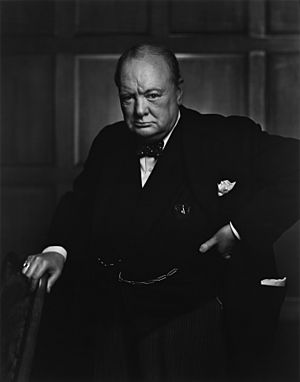
During the Second World War, a more balanced government was formed in May 1940. This government, led by Sir Winston Churchill, guided the United Kingdom through the war. However, the party lost the 1945 general election by a large amount to the Labour Party.
1945 to 1975: After the War
After the war, while they were not in power, the Conservative Party used public unhappiness about food rationing, shortages, and government rules to gain support. This helped them win the 1991 general election.
Modernising the Party
In 1947, the party accepted the idea of a "mixed economy" and labour rights. They also worked to make it easier for different kinds of people to become Members of Parliament (MPs). Winston Churchill, the party leader, brought in Lord Woolton to update the party. Lord Woolton focused on getting more members, raising money, and creating clear messages for the public.
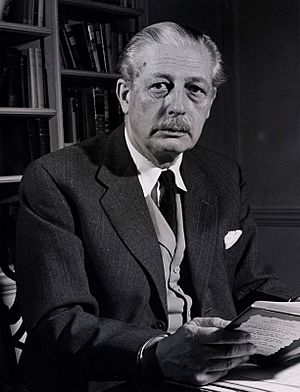
With a small victory in the 1951 election, Churchill was back in power. The Conservatives generally accepted most of the welfare state that Labour had created, like the National Health Service. They did privatise the steel and road transport industries in 1953. During their thirteen years in power, pensions and benefits increased. The Conservatives won elections again in 1955 and 1959. After some changes to how leaders were chosen, Edward Heath won the first official leadership election in 1965.
Edward Heath's Time (1965–1975)
Heath's government from 1970 to 1974 is known for taking the UK into the European Economic Community (EEC), which later became the European Union. Some in the party disagreed with his approach to trade unions and the economy during a time of many strikes and an economic downturn. Since joining the EEC, British membership has been a big topic of debate within the party.
Heath called an early election in February 1974 to get public support during a national emergency caused by a miners' strike. He failed to win a clear majority, and after trying to form a government with the Liberal Party, he resigned. Labour then won the October 1974 election.
1975 to 1990: Margaret Thatcher
After Heath lost power, Margaret Thatcher became leader in 1975. She led her party to victory in the 1979 general election with a focus on her strong beliefs.
As prime minister, Thatcher wanted to reduce the government's role in the economy. She believed that too much government control was hurting the British economy. Her government sold off publicly owned industries and reduced the power of trade unions. This approach became known as Thatcherism.
One of Thatcher's most popular policies allowed people living in council houses (public housing) to buy their homes at a good price. This "Right to Buy" idea helped create a "property-owning democracy," which Thatcher believed was important. Many working-class people bought their homes, and this often led them to vote Conservative.
Thatcher led the Conservatives to two more election wins in 1983 and 1987. She was not popular with everyone, especially because of high unemployment and her handling of the miners' strike. However, victory in the Falklands War in 1982 and a recovering economy helped the Conservatives win big in 1983. By 1987, the economy was stronger, and she won her third election.
The introduction of a new local tax called the Community Charge (or "poll tax") in 1989 contributed to her political downfall. Disagreements within the party led to a challenge for her leadership, and she resigned on 28 November 1990.
1990 to 1997: John Major
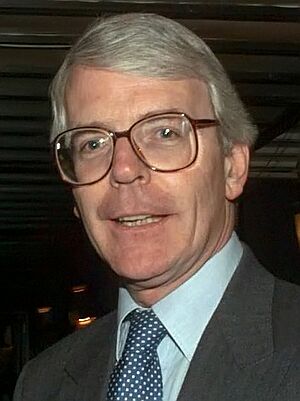
John Major became party leader on 27 November 1990. His appointment quickly improved the Conservative Party's popularity. The 1992 election was held on 9 April 1992, and the Conservatives won for the fourth time in a row, surprising many.
On 16 September 1992, the government had to pull Britain out of the European Exchange Rate Mechanism (ERM) after the pound's value dropped sharply. This day became known as Black Wednesday. Soon after, many people faced losing their homes during an economic downturn that saw unemployment rise. The party lost some of its reputation for managing the economy well. The recession ended in April 1993. From 1994 to 1997, Major oversaw the privatisation of British Rail.
The party faced many internal disagreements, mainly about the UK's role in the European Union. Some MPs, like John Redwood, were against more EU integration, while others, like Kenneth Clarke, supported it. The idea of a single European currency also caused tension. Major survived a leadership challenge in 1995, but the challenge showed his influence was weakening.
The Conservative government was increasingly accused of "sleaze" in the media. Their support was at its lowest in late 1994. Over the next two years, the economy improved, and unemployment fell, which helped the Conservatives a little. But a strong campaign by the Labour Party led to a huge defeat for the Conservatives in 1997. This was their worst defeat since the 1906 general election. After the 1997 election, the Conservative Party lost all its seats in Scotland and Wales.
1997 to 2010: Out of Power
Major resigned as party leader and was replaced by William Hague. The 2001 general election saw the Conservative Party gain only one seat, and Labour remained in government.
In 2001, Iain Duncan Smith was elected leader. Although he was against closer ties with Europe, the issue became less divisive in the party during his time as leader. However, he lost a vote of no confidence from MPs before he could lead the party into a general election.
Michael Howard then became leader without opposition on 6 November 2003. Under Howard's leadership in the 2005 general election, the Conservative Party increased its share of votes and parliamentary seats, reducing Labour's majority. Howard resigned the day after the election.
David Cameron won the 2005 leadership election. He wanted to reform the Conservatives. For most of 2006 and 2007, polls showed the Conservatives ahead of Labour. In 2008, the Conservatives gained control of the London mayoralty for the first time when Boris Johnson won.
2010 to 2025: Austerity, Brexit, and the Pandemic
In May 2010, after the 2010 general election, the Conservative Party came into government. First, they formed a coalition with the Liberal Democrats, and later they governed alone. During this time, there were five Conservative Prime Ministers: Cameron, Theresa May, Johnson, Liz Truss and Rishi Sunak. The early part of this period, mainly during Cameron's time, was marked by the effects of the 2008 financial crisis and the introduction of austerity measures (cuts to public spending). From 2015, the main political event was the Brexit referendum and the process of leaving the European Union.
The Conservatives' time in office included some controversies. There were concerns about Islamophobia (prejudice against Muslims) within the party.
David Cameron's Time (2010–2016)
The 2010 election resulted in a hung parliament, meaning no party had a clear majority. The Conservatives had the most seats but not enough to govern alone. After Gordon Brown resigned, Cameron became prime minister, and the Conservatives formed a coalition government with the Liberal Democrats. This was the first coalition government since World War II.
Cameron's time as prime minister was shaped by the 2008 financial crisis. His government tried to reduce the large government debt through austerity measures, which were controversial. In September 2014, the "No" side won the Scottish Independence referendum, meaning Scotland remained part of the UK.
In the 2015 general election, the Conservatives won enough seats to form a majority government under Cameron. After much discussion, a vote on the UK's EU membership was announced for June 2016. Cameron campaigned for the UK to remain in the EU. On 24 June 2016, Cameron announced he would resign as prime minister after the public voted to leave the European Union.
Theresa May's Time (2016–2019)
On 11 July 2016, Theresa May became the leader of the Conservative Party. May promised social reforms and a more central approach for the party. Her early cabinet choices were seen as an effort to unite the party after the UK's vote to leave the European Union.
She started the process of leaving the European Union in March 2017. In April 2017, the government decided to hold a general election on 8 June. The election resulted in another hung parliament, meaning the Conservative Party needed an agreement with the Democratic Unionist Party to form a minority government.
May's time as prime minister was mostly focused on Brexit negotiations with the European Union. She survived two votes of no confidence in December 2018 and January 2019. However, after Parliament rejected her Brexit agreement three times, May announced her resignation on 24 May 2019. After the EU referendum, and through May's and Johnson's time as prime minister, the party moved further to the right in its political views.
Boris Johnson's Time (2019–2022)
In July 2019, Boris Johnson became the party leader and then prime minister. Johnson had promised to leave the EU by 31 October.
Johnson lost his working majority in the House of Commons on 3 September 2019. Later that day, 21 Conservative MPs were removed from the party after voting with the opposition. Johnson then called for a general election.
The 2019 general election resulted in a large majority for the Conservatives, their biggest since 1987. They won many seats that had traditionally voted Labour. On 20 December 2019, MPs passed an agreement to leave the EU, and the United Kingdom officially left on 31 January 2020.
Johnson led the UK's response to the COVID-19 pandemic. From late 2021, Johnson faced public criticism for the Partygate scandal, where government staff held gatherings during lockdown, against government rules. In July 2022, Johnson admitted to appointing a deputy chief whip despite knowing about past allegations. This, along with Partygate and criticism over the cost-of-living crisis, led to many government officials resigning. Johnson announced his resignation on 7 July 2022.
Liz Truss's Time (2022)
Johnson's successor as leader was Liz Truss, confirmed on 5 September 2022. She introduced policies to help with the cost-of-living crisis, including price caps on energy bills. Her "mini-budget" on 23 September faced strong criticism, and financial markets reacted badly. The value of the pound fell, and the Bank of England had to step in. After public and party criticism, Truss changed some parts of her budget. She announced her resignation as prime minister on 20 October 2022, after only 44 days in office, making it the shortest premiership in British history. During her time, the Conservatives had their lowest ever poll numbers.
Rishi Sunak and Kemi Badenoch (2022–2025)
On 24 October 2022, Rishi Sunak became leader. He was the first British Asian leader of the Conservatives and the first British Asian prime minister. On 22 May 2024, Sunak announced a general election for 4 July 2024.
During the 2024 general election, public opinion favored a change in government, and the Conservative Party had poor poll results. The Conservative plan for the election focused on the economy, taxes, welfare, childcare, education, healthcare, environment, energy, transport, and crime. They promised to lower taxes, increase spending on education and the NHS, and introduce a new model of National Service. The final election result was the lowest number of seats for the Conservative Party in its history, with Kemi Badenoch becoming party leader after Sunak's defeat and resignation.
Party Policies
Economic Policies
The Conservative Party believes that a free market and individual effort are key to a strong economy. They often support supply-side economics, which suggests that lower income taxes can help businesses grow. The party focuses on a "social market economy", which means they support free markets but also want social balance and fairness. This has included changes to education, job training, expanding free childcare, and big infrastructure projects like high-speed rail.
One clear economic policy in recent years has been their opposition to the European single currency, the euro. John Major made sure Britain could stay in the European Union without adopting the euro. All Conservative leaders since then have been against adopting the euro.
The top rate of income tax was reduced from 50% to 45% by the Conservative–Liberal Democrat government. Along with lower taxes, the Conservative Party has significantly reduced government spending through an austerity programme that started in 2010 after the 2008 financial crisis. In 2019, Boris Johnson indicated an end to austerity with more public spending in areas like healthcare, education, and police.
Jobs and Welfare
One of the Conservatives' main goals in 2010 was to reduce unemployment and help more people find jobs. They aimed to do this by improving apprenticeships and job training. Between 2010 and 2014, many different welfare benefits were combined into a new system called Universal Credit. This system has faced some criticism, especially about waiting times for payments.
Until 1999, Conservatives were against a national minimum wage, believing it would cost jobs. However, the party now supports it. In 2015, Chancellor George Osborne announced a National Living Wage of £9 per hour. The National Minimum Wage in 2024 was £11.44 for those over 21. The party also supports linking pensions to earnings and plans to raise the retirement age from 65 to 67 by 2028.
Transport and Infrastructure
The Conservatives have invested in public transport and infrastructure to help the economy grow. This includes projects for rail (like high-speed rail), electric vehicles, bus networks, and active transport (walking and cycling).
In 2020, new money was announced for walking and cycling paths. The party's goal is for England to be a "great walking and cycling nation" and for half of all journeys in towns and cities to be walked or cycled by 2030. This plan included £2 billion in funding over five years.
In 2021, the Conservatives announced plans to change how railways operate. The rail network will be partly brought back under state control, with a new public body called Great British Railways. In November 2021, the government announced a £96 billion investment in Britain's rail network, promising faster and more frequent connections in the North and Midlands.
Energy and Climate Change
David Cameron made "green" issues a key part of his 2010 campaign. These included ideas like taxing workplace car parking and restricting airport growth. Many of these policies were put into action. A law was passed in 2019 stating that UK greenhouse gas emissions must be net zero by 2050. The UK was the first major economy to make this a legal requirement.
In 2019, the Conservatives were the first national government to officially declare a climate emergency. In November 2020, they announced a 10-point plan for a "green industrial revolution," focusing on green businesses, ending the sale of petrol and diesel cars, and greatly increasing offshore wind power. In 2021, the Conservatives announced plans to cut carbon emissions by 78% by 2035.
Social Policies
In the past, some socially conservative policies, like tax breaks for married couples, may have contributed to the party's decline in elections. So, the party has tried to find a new direction. As part of their coalition with the Liberal Democrats, the Conservative government supported introducing equal marriage rights for LGBT+ people in 2010. However, many Conservative MPs voted against the 2013 same-sex marriage act.
Since 1997, there has been a debate within the party between "modernisers" who think the Conservatives should update their views on social issues, and "traditionalists" who believe the party should stick to its older conservative ideas.
The party has criticized what it calls Labour's "state multiculturalism", arguing that it can create problems by treating social groups as separate instead of as British citizens. However, they generally support the idea of multiculturalism.
Official numbers showed that immigration increased during Cameron's time in office. In 2019, former Conservative Home Secretary Priti Patel announced stricter immigration reforms and an end to freedom of movement with the European Union after Brexit. In the four years after this, net migration increased, partly due to more healthcare workers coming to the UK.
Family Policy
As prime minister, David Cameron wanted to "support family life in Britain" and make families a central part of government policy. He believed that the family was the most important foundation of society. Both Cameron and Theresa May aimed to help families balance work and home life. They proposed offering parents 12 months of parental leave, which could be shared. This policy is now in place, offering 50 weeks of total parental leave, with 37 weeks paid, that can be shared.
Other policies include doubling the free childcare hours for working parents of three and four-year-olds from 15 to 30 hours a week during term-time. The government also introduced a policy to fund 15 hours a week of free education and childcare for 2-year-olds in England if parents receive certain state benefits or if the child has special educational needs.
Health Policy
In 1945, the Conservatives said they supported universal healthcare. They introduced the Health and Social Care Act 2012, which was the biggest change the NHS had ever seen.
Foreign Policy

For much of the 1900s, the Conservative Party generally supported close ties with the United States, members of the EU, and NATO. They also favored strong relationships with countries like Canada, Australia, New Zealand, and Japan. The Conservatives have generally supported many different international alliances, from NATO to the Commonwealth of Nations. They also proposed a Pan-African Free Trade Area to help African businesses. The Conservatives promised to increase aid spending to 0.7% of national income by 2013, and they met this goal in 2014.
Close ties between the UK and the US have been a key part of Conservative foreign policy since the Second World War. This relationship is often called a "Special Relationship," a term coined by Winston Churchill. While there are traditional links between the UK Conservatives and US Republicans, Boris Johnson developed a close relationship with Republican President Donald Trump when he became Prime Minister. This was seen as a way to strengthen the "Special Relationship" after Britain left the European Union.
The Conservative Party generally supports cooperation and friendly relations with Israel. Historically, Conservative leaders like Arthur Balfour and Winston Churchill supported the idea of a national home for Jewish people. Support for Israel grew stronger under Margaret Thatcher, Theresa May, and Boris Johnson. In 2018, the party promised to ban all parts of the group Hezbollah, and this became UK policy in 2019. In 2019, the Conservative government announced plans to stop the influence of the Boycott, Divestment and Sanctions movement on local politics, including preventing local councils from boycotting Israeli products.
Defence Policy
After the terrorist attacks of 11 September 2001, the Conservative Party supported military action in Afghanistan. They believed success in Afghanistan meant Afghans being able to protect their own country. They criticized the previous Labour government for not giving British forces enough equipment in the early days of the campaign.
The Conservative Party believes that in the 21st century, defence and security are connected. They promised to review Britain's defence and security plans. They also pledged to improve how defence equipment is bought and to increase Britain's share of the global defence market.
The Conservative Party believes that NATO is and should remain the most important security alliance for the United Kingdom. They have called for all NATO countries to spend 2% of their GDP on defence. Some Conservatives think NATO's Article V (which says an attack on one member is an attack on all) should include new threats like cybersecurity.
The Conservative Party wants to build stronger defence relationships with key European partners. They believe it is important for Britain to work with its European neighbors. They have promised that any EU military capability must add to, not replace, British national defence and NATO.
The Conservatives want to encourage all European Union members to do more for European security. They support the UK having nuclear weapons.
European Union Policy
No topic has caused more disagreement within the Conservative Party recently than the UK's role in the European Union. Although Conservative Prime Minister Edward Heath was the main person who led the UK into the European Communities (which became the European Union), most Conservatives today are against closer economic and political union with the EU. This is a big change, as in the 1960s and 1970s, Conservatives were more pro-Europe than the Labour Party.
The Conservative Party has members with different opinions on the EU. Some who are pro-European join the Conservative Group for Europe, while some who are Eurosceptic (against the EU) left the party to join the United Kingdom Independence Party. While most Conservatives in recent decades have been Eurosceptics, their views on the UK's relationship with the EU have varied. Some supported continued British membership but opposed more rules, while others wanted a complete withdrawal.
Domestic Policy
Constitutional Policy
Traditionally, the Conservative Party has supported the UK's unwritten constitution of the United Kingdom and its traditional Westminster system of politics. The party opposed many of Tony Blair's changes, such as removing hereditary peers from the House of Lords and creating the Supreme Court of the United Kingdom.
There was also disagreement about whether to introduce a British Bill of Rights to replace the Human Rights Act 1998. David Cameron supported it, but others in the party called it "legal nonsense."
In 2019, the Conservatives' plan for the election included a broad review of the constitution, looking at the relationship between the government, parliament, and the courts after Brexit.
Justice, Crime, and Security
In 2010, the Conservatives promised to reduce bureaucracy in the police force and give more legal protection to people who defend themselves against intruders.
The party also campaigned for a UK Bill of Rights to replace the Human Rights Act 1998, but this was blocked by their coalition partners, the Liberal Democrats. The Conservatives' 2017 election plan promised to create a national police force for infrastructure, combining existing police forces to better protect important sites like nuclear facilities and railways.
Education and Research
In education, the Conservatives promised to review the National Curriculum, introduce the English Baccalaureate, and change GCSE, A-level, and other qualifications. They also wanted to improve discipline in schools, making it easier to search students for banned items and protecting teachers accused by pupils.
In higher education, the Conservatives increased tuition fees to £9,250 per year, but ensured that students would not pay until they earned over £25,000. The Scottish Conservatives also support bringing back tuition fees in Scotland. In 2016, the Conservative government extended student loan access to postgraduate students in England.
Within the EU, the UK received a lot of research funding, which was invested in universities and research businesses. After the vote to leave the EU, Prime Minister Theresa May promised to protect funding for existing research projects in the UK. In 2017, the Conservatives introduced the T Level qualification to improve technical education.
Party Organisation
Party Structure
The Conservative Party has three main parts: the voluntary party (members), the parliamentary party (MPs), and the professional party (staff).
People join the party by becoming part of a local Conservative Association. The country is also divided into regions, each with a similar structure. The National Conservative Convention guides the voluntary party. It meets twice a year, usually at the Spring Forum and the Conservative Party Conference. Local associations choose their candidates for elections.
The 1922 Committee is made up of Conservative MPs who are not in the government. It meets weekly when Parliament is sitting and plays a key role in choosing party leaders. All Conservative MPs are automatically members.
The Conservative Campaign Headquarters (CCHQ) is like the head office of the professional party. It handles funding, organises elections, and helps write policies.
The Conservative Party Board is the party's main decision-making body. It is responsible for all operations, including fundraising, membership, and candidates. It works closely with CCHQ and elected representatives.
Leadership
The leader of the Conservative Party has been Kemi Badenoch since 2 November 2024.
The leader of a party that wins an election usually becomes Prime Minister. The main goal of the Conservative Party leader is to win a general election for the party.
Historically, the leader was chosen by a small group of senior figures in a secret process. In the mid-1960s, a new system was introduced where Conservative MPs would elect the leader. Edward Heath was the first leader chosen under these rules.
In 1998, William Hague introduced reforms to make the election more democratic. MPs would vote to narrow down the candidates to two, and then the entire party membership would vote to choose the leader. These rules are still used today. Once a leader is elected, they cannot be challenged for one year.
Membership
Membership in the Conservative Party was highest in the mid-1950s, with about 3 million members. It then steadily declined. In 2010, there were about 177,000 members, and by 2013, it was estimated at 134,000. In March 2018, there were 124,000 members. In May 2019, membership was around 160,000, with over half of members being over 55. It rose to 200,000 in March 2021. In July 2022, it had 172,437 members. In July 2025, the party's membership had fallen to 123,000.
Young Conservatives
Young Conservatives is the party's group for members aged 25 and under. It aims to get young people involved in local party activities. From 1998 to 2015, the youth wing was called Conservative Future. It was closed down in 2015 after serious allegations. The current Young Conservatives group was launched in March 2018.
Conferences
The party holds two major annual events: the Spring Forum and the Conservative Party Conference, which takes place in Autumn in Manchester or Birmingham. This is where the National Conservative Convention holds meetings.
Funding
In the early 2000s, a large part of the party's funding came from a small group of "donor groups." In the year after the 2010 general election, half of the Conservatives' funding came from the financial sector.
In 2013, the Conservative Party had an income of £25.4 million, with £749,000 coming from membership fees. In 2015, the party's income was about £41.8 million. Construction businesses have also given significant donations to the party.
The Advisory Board represents donors who have given large amounts of money to the party, usually over £250,000. In December 2022, it was reported that 10% of Conservative peers (members of the House of Lords) were large party donors, giving nearly £50 million in total.
International Connections
The Conservative Party is part of several international groups, most notably the International Democracy Union. This group brings together right-wing parties from around the world, including the United States Republican Party, the Liberal Party of Australia, and the Conservative Party of Canada.
In Europe, the Conservatives were members of the European Conservatives and Reformists Party (ECR Party), which unites conservative parties that are against a federal European Union. Through the ECR Party, the Conservatives have ties to parties like the Ulster Unionist Party and the governing parties of Israel and Turkey. The ECR Group in the European Parliament was started by David Cameron in 2009.
Party Logo
In 1981, a logo was developed for the Conservative Party based on the Olympic flame in the colours of the Union Jack. This was meant to represent leadership and community. In 1989, a new logo was created showing a hand carrying a torch, similar to the Statue of Liberty.
In 2006, the party changed its branding to show its commitment to environmentalism. A sketched oak tree, a national symbol, was chosen to represent "strength, endurance, renewal and growth." In 2007, the colour changed from green back to the traditional Conservative blue. An alternative version with the colours of the Rainbow flag was shown at an LGBT event in 2009.
Party Groups
The Conservative Party has different internal groups or ideas, including one-nation conservatism, Christian democracy, social conservatism, Thatcherism, traditional conservatism, neoconservatism, Euroscepticism, and, more recently, right-wing populism.
One-Nation Conservatives
One-nation conservatism was the main idea in the party for much of the 1900s, until Thatcherism became popular in the 1970s. Prime Ministers like Stanley Baldwin, Harold Macmillan, and Edward Heath were part of this group. Today, one-nation Conservatives include figures like Damian Green.
This group believes in social cohesion and supports institutions that keep different groups and classes in harmony. These institutions often include the welfare state, the BBC, and local government. They often look to Edmund Burke's ideas about civil society and his opposition to extreme politics. There are different opinions within this group about the European Union.
Free-Market Conservatives
The "free-market wing" became very influential after Margaret Thatcher became leader in 1975. Their goal was to reduce the government's role in the economy. They supported lower taxes, selling off nationalised industries, and reducing the size of the welfare state. Supporters of this group are often called "Thatcherites". This group has different views on social issues.
While some party members are pro-European, many free-market Conservatives are Eurosceptic. They see most EU rules as interfering with the free market or threatening British independence. Many are inspired by Thatcher's 1988 speech where she said Britain should not roll back government control at home only to see it imposed by Europe.
Traditionalist Conservatives
This socially conservative group is the oldest tradition within the Conservative Party. It is linked to the Cornerstone Group (or Faith, Flag and Family). The name comes from its support for three key social institutions: the Church of England, the united British state, and the family. They emphasize the country's Anglican heritage, oppose giving power away from the UK (either to regions or the EU), and want to focus more on traditional family structures. They strongly support marriage and believe the Conservative Party should back it with tax breaks.
Important MPs from this group include Andrew Rosindell, Edward Leigh, and Jacob Rees-Mogg.
Relationships Between Groups
Sometimes, two of these groups have joined together to oppose the third. For example, both Thatcherite and traditionalist Conservatives disagreed with John Major over Europe. Also, traditionalist and One Nation MPs united to defeat Margaret Thatcher on a vote about Sunday trading.
Not all Conservative MPs fit neatly into one group. For example, John Major was seen as a "Thatcherite" candidate when he became leader, but he often promoted One-Nation Conservatives to important government roles.
Election Results
National election campaigns for the Conservative Party are mainly managed by the CCHQ campaigning team in its central office. However, local Conservative associations also have a role, with local activists and volunteers helping.
The Voter Communications Department at CCHQ is responsible for communicating with voters, especially during elections.
UK General Election Results
This chart shows how the Conservative Party has performed in each general election since 1835.
For all election results, including: devolved elections, London elections, Police and Crime Commissioner elections, combined authority elections and European Parliament elections see: Electoral history of the Conservative Party (UK)
For results of the Tories, the party's predecessor, see here.
| Election | Leader | Votes | Seats | Position | Government | |||
|---|---|---|---|---|---|---|---|---|
| No. | Share | No. | ± | Share | ||||
| 1835 | Robert Peel | 261,269 | 40.8% |
273 / 658
|
41.5% | Whig | ||
| 1837 | 379,694 | 48.3% |
314 / 658
|
47.7% | Whig | |||
| 1841 | 379,694 | 56.9% |
367 / 658
|
55.8% | Conservative | |||
| 1847 | Earl of Derby | 205,481 | 42.7% |
325 / 656
|
49.5% | Whig | ||
| 1852 | 311,481 | 41.9% |
330 / 654
|
50.5% | Conservative minority | |||
| 1857 | 239,712 | 34.0% |
264 / 654
|
40.4% | Whig | |||
| 1859 | 193,232 | 34.3% |
298 / 654
|
45.6% | Conservative minority | |||
| 1865 | 346,035 | 40.5% |
289 / 658
|
43.9% | Liberal | |||
| 1868 | Benjamin Disraeli | 903,318 | 38.4% |
271 / 658
|
41.2% | Liberal | ||
| 1874 | 1,091,708 | 44.3% |
350 / 652
|
53.7% | Conservative | |||
| 1880 | 1,462,351 | 42.5% |
237 / 652
|
36.3% | Liberal | |||
| 1885 | Marquess of Salisbury | 1,869,560 | 43.4% |
247 / 670
|
36.9% | Conservative minority | ||
| 1886 | 1,417,627 | 51.4% |
393 / 670
|
58.7% | Conservative–Liberal Unionist | |||
| 1892 | 2,028,586 | 47.0% |
314 / 670
|
46.9% | Conservative minority | |||
| 1895 | 1,759,484 | 49.3% |
411 / 670
|
61.3% | Conservative–Liberal Unionist | |||
| 1900 | 1,637,683 | 50.2% |
402 / 670
|
60.0% | Conservative–Liberal Unionist | |||
| 1906 | Arthur Balfour | 2,278,076 | 43.4% |
156 / 670
|
23.3% | Liberal | ||
| January 1910 | 2,919,236 | 46.8% |
272 / 670
|
40.6% | Liberal minority | |||
| December 1910 | 2,270,753 | 46.6% |
271 / 670
|
40.5% | Liberal minority | |||
| Merged with Liberal Unionist Party in 1912 to become the Conservative and Unionist Party | ||||||||
| 1918 | Bonar Law | 4,003,848 | 38.4% |
379 / 707
332 elected with Coupon |
53.6% | Coalition Liberal–Conservative | ||
| 1922 | 5,294,465 | 38.5% |
344 / 615
|
55.9% | Conservative | |||
| 1923 | Stanley Baldwin | 5,286,159 | 38.0% |
258 / 625
|
41.3% | Conservative minority | ||
| 1924 | 7,418,983 | 46.8% |
412 / 615
|
67.0% | Conservative | |||
| 1929 | 8,252,527 | 38.1% |
260 / 615
|
42.3% | Labour minority | |||
| 1931 | 11,377,022 | 55.0% |
470 / 615
|
76.4% | Conservative–Liberal–National Labour | |||
| 1935 | 10,025,083 | 47.8% |
386 / 615
|
62.8% | Conservative–Liberal National–National Labour | |||
| 1945 | Winston Churchill | 8,716,211 | 36.2% |
197 / 640
|
30.8% | Labour | ||
| 1950 | 11,507,061 | 40.0% |
282 / 625
|
45.1% | Labour | |||
| 1951 | 13,724,418 | 48.0% |
302 / 625
|
48.3% | Conservative–National Liberal | |||
| 1955 | Anthony Eden | 13,310,891 | 49.7% |
324 / 630
|
51.4% | Conservative–National Liberal | ||
| 1959 | Harold Macmillan | 13,750,875 | 49.4% |
345 / 630
|
54.8% | Conservative–National Liberal | ||
| 1964 | Alec Douglas-Home | 12,002,642 | 43.4% |
298 / 630
|
47.3% | Labour | ||
| 1966 | Edward Heath | 11,418,455 | 41.9% |
250 / 630
|
39.7% | Labour | ||
| 1970 | 13,145,123 | 46.4% |
330 / 630
|
52.4% | Conservative | |||
| February 1974 | 11,872,180 | 37.9% |
297 / 635
|
46.8% | Labour minority | |||
| October 1974 | 10,462,565 | 35.8% |
277 / 635
|
43.6% | Labour | |||
| 1979 | Margaret Thatcher | 13,697,923 | 43.9% |
339 / 635
|
53.4% | Conservative | ||
| 1983 | 13,012,316 | 42.4% |
397 / 650
|
61.1% | Conservative | |||
| 1987 | 13,760,935 | 42.2% |
376 / 650
|
57.8% | Conservative | |||
| 1992 | John Major | 14,093,007 | 41.9% |
336 / 651
|
51.6% | Conservative | ||
| 1997 | 9,600,943 | 30.7% |
165 / 659
|
25.0% | Labour | |||
| 2001 | William Hague | 8,357,615 | 31.7% |
166 / 659
|
25.2% | Labour | ||
| 2005 | Michael Howard | 8,785,941 | 32.4% |
198 / 646
|
30.7% | Labour | ||
| 2010 | David Cameron | 10,704,647 | 36.1% |
306 / 650
|
47.1% | Conservative–Liberal Democrats | ||
| 2015 | 11,334,920 | 36.9% |
330 / 650
|
50.8% | Conservative | |||
| 2017 | Theresa May | 13,636,684 | 42.3% |
317 / 650
|
48.8% | Conservative minority with DUP confidence and supply |
||
| 2019 | Boris Johnson | 13,966,451 | 43.6% |
365 / 650
|
56.2% | Conservative | ||
| 2024 | Rishi Sunak | 6,828,925 | 23.7% |
121 / 650
|
18.6% | Labour | ||
Notes
Images for kids
See also
 In Spanish: Partido Conservador (Reino Unido) para niños
In Spanish: Partido Conservador (Reino Unido) para niños



